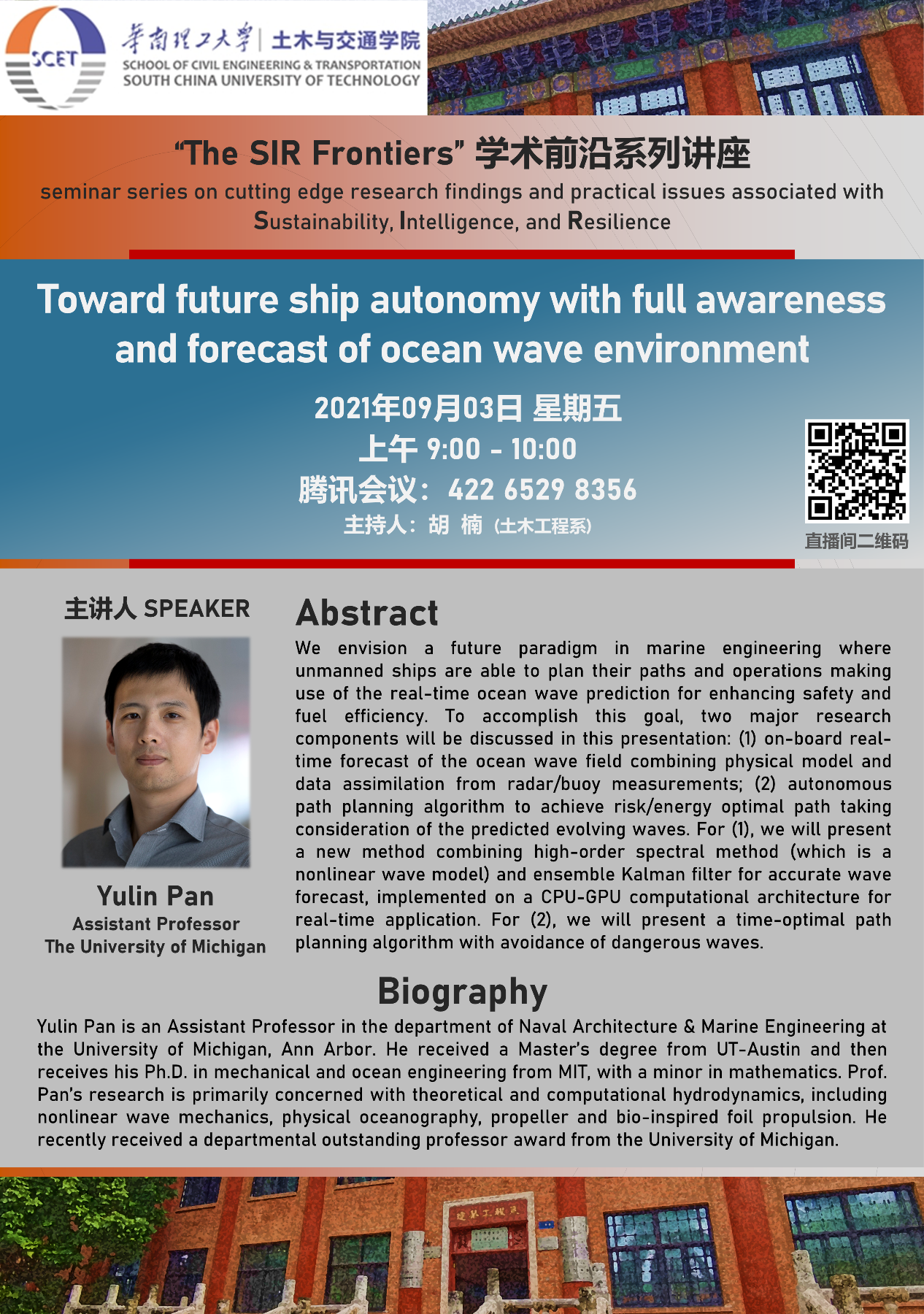题 目:通过对海浪环境的充分认知与预测,迈向未来船舶自动化
Toward future ship autonomy with full awareness and forecast of ocean wave environment
时 间:2021年09月03日周五9:00-10:00
地 点:腾讯会议 ID:422 6529 8356 (若300人满请入直播间)
腾讯直播间:https://meeting.tencent.com/l/QALGLWoVMAcS
报告人:潘玉林(美国密歇根大学,船舶与海洋工程系)
报告人官方主页:https://name.engin.umich.edu/people/pan-yulin/
欢迎广大师生参加!
土木与交通学院
2021年08月31日

报告人简介:
潘玉林,目前是美国密歇根大学安娜堡分校船舶与海洋工程系助理教授。他在华中科技大学获得本科学位,随后在德克萨斯大学奥斯汀分校获得硕士学位,之后在麻省理工学院获得机械与海洋工程博士学位,辅修数学专业。他的主要研究方向为理论和计算流体动力学,包括非线性波动力学、物理海洋学、螺旋桨和仿生翼推进。潘教授最近刚获得密歇根大学船舶与海洋工程系杰出教授奖。
Yulin Pan is an Assistant Professor in the department of Naval Architecture & Marine Engineering at the University of Michigan, Ann Arbor. He received a Master’s degree from UT-Austin and then receives his Ph.D. in mechanical and ocean engineering from MIT, with a minor in mathematics. Prof. Pan’s research is primarily concerned with theoretical and computational hydrodynamics, including nonlinear wave mechanics, physical oceanography, propeller and bio-inspired foil propulsion. He recently received a departmental outstanding professor award from the University of Michigan.
报告摘要:
我们所能预见的未来船海工程,拥有能够自主的规划路径和操作无人驾驶船舶,并通过实时预测海浪来提高安全性和燃料的利用效率。为实现这一目标,本次报告将讨论两个主要研究内容:(1)结合物理模式和雷达/浮标测量的数据同化技术实现船舶附近海浪的实时预报;(2)结合预测的海浪状态,通过自动化路径规划算法生成风险/能量最佳路径。对于第一部分,我们将提出一种新型的预测海浪方法,这种方法是将高阶谱法(非线性波模型)与集合卡尔曼滤波进行结合,并在CPU-GPU计算架构上实现实时的预测。对于第二部分,我们将给出一种能够规避海浪危险且节省时间的路径规划算法。
We envision a future paradigm in marine engineering where unmanned ships are able to plan their paths and operations making use of the real-time ocean wave prediction for enhancing safety and fuel efficiency. To accomplish this goal, two major research components will be discussed in this presentation: (1) on-board real-time forecast of the ocean wave field combining physical model and data assimilation from radar/buoy measurements; (2) autonomous path planning algorithm to achieve risk/energy optimal path taking consideration of the predicted evolving waves. For (1), we will present a new method combining high-order spectral method (which is a nonlinear wave model) and ensemble Kalman filter for accurate wave forecast, implemented on a CPU-GPU computational architecture for real-time application. For (2), we will present a time-optimal path planning algorithm with avoidance of dangerous waves.



